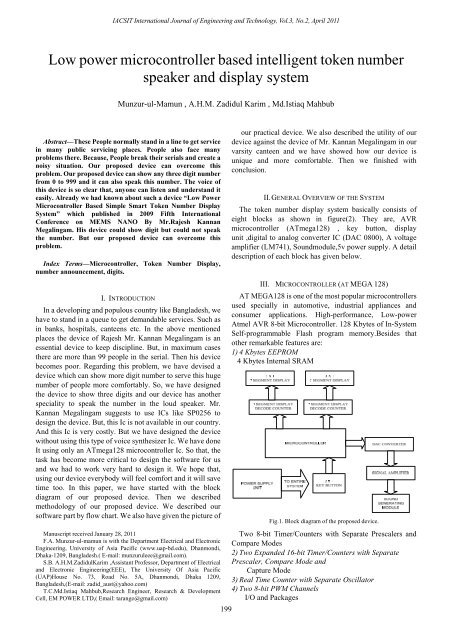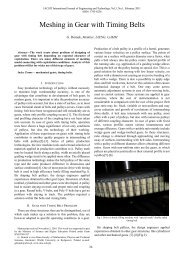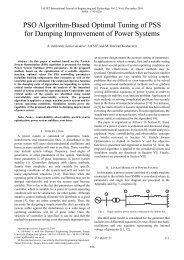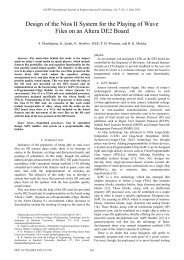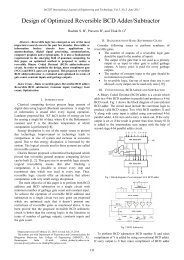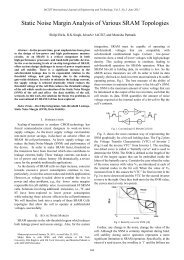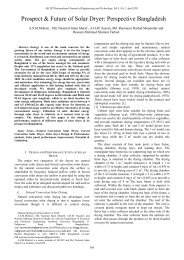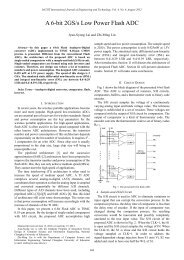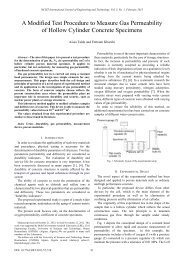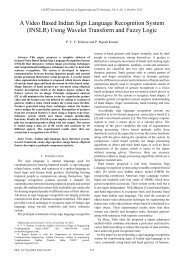Low power microcontroller based intelligent token number ... - IJET
Low power microcontroller based intelligent token number ... - IJET
Low power microcontroller based intelligent token number ... - IJET
Create successful ePaper yourself
Turn your PDF publications into a flip-book with our unique Google optimized e-Paper software.
IACSIT International Journal of Engineering and Technology, Vol.3, No.2, April 2011<br />
<strong>Low</strong> <strong>power</strong> <strong>microcontroller</strong> <strong>based</strong> <strong>intelligent</strong> <strong>token</strong> <strong>number</strong><br />
speaker and display system<br />
Munzur-ul-Mamun , A.H.M. Zadidul Karim , Md.Istiaq Mahbub<br />
Abstract—These People normally stand in a line to get service<br />
in many public servicing places. People also face many<br />
problems there. Because, People break their serials and create a<br />
noisy situation. Our proposed device can overcome this<br />
problem. Our proposed device can show any three digit <strong>number</strong><br />
from 0 to 999 and it can also speak this <strong>number</strong>. The voice of<br />
this device is so clear that, anyone can listen and understand it<br />
easily. Already we had known about such a device “<strong>Low</strong> Power<br />
Microcontroller Based Simple Smart Token Number Display<br />
System” which published in 2009 Fifth International<br />
Conference on MEMS NANO By Mr.Rajesh Kannan<br />
Megalingam. His device could show digit but could not speak<br />
the <strong>number</strong>. But our proposed device can overcome this<br />
problem.<br />
Index Terms—Microcontroller, Token Number Display,<br />
<strong>number</strong> announcement, digits.<br />
I. INTRODUCTION<br />
In a developing and populous country like Bangladesh, we<br />
have to stand in a queue to get demandable services. Such as<br />
in banks, hospitals, canteens etc. In the above mentioned<br />
places the device of Rajesh Mr. Kannan Megalingam is an<br />
essential device to keep discipline. But, in maximum cases<br />
there are more than 99 people in the serial. Then his device<br />
becomes poor. Regarding this problem, we have devised a<br />
device which can show more digit <strong>number</strong> to serve this huge<br />
<strong>number</strong> of people more comfortably. So, we have designed<br />
the device to show three digits and our device has another<br />
speciality to speak the <strong>number</strong> in the loud speaker. Mr.<br />
Kannan Megalingam suggests to use ICs like SP0256 to<br />
design the device. But, this Ic is not available in our country.<br />
And this Ic is very costly. But we have designed the device<br />
without using this type of voice synthesizer Ic. We have done<br />
It using only an ATmega128 <strong>microcontroller</strong> Ic. So that, the<br />
task has become more critical to design the software for us<br />
and we had to work very hard to design it. We hope that,<br />
using our device everybody will feel comfort and it will save<br />
time too. In this paper, we have started with the block<br />
diagram of our proposed device. Then we described<br />
methodology of our proposed device. We described our<br />
software part by flow chart. We also have given the picture of<br />
Manuscript received January 28, 2011<br />
F.A. Munzur-ul-mamun is with the Department Electrical and Electronic<br />
Engineering, University of Asia Pacific (www.uap-bd.edu), Dhanmondi,<br />
Dhaka-1209, Bangladesh.( E-mail: munzuruleee@gmail.com).<br />
S.B. A.H.M.ZadidulKarim ,Assistant Professor, Department of Electrical<br />
and Electronic Engineering(EEE), The University Of Asia Pacific<br />
(UAP)House No. 73, Road No. 5A, Dhanmondi, Dhaka 1209,<br />
Bangladesh,(E-mail: zadid_aust@yahoo.com)<br />
T.C.Md.Istiaq Mahbub,Research Engineer, Research & Development<br />
Cell, EM POWER LTD,( Email: tarango@gmail.com)<br />
199<br />
our practical device. We also described the utility of our<br />
device against the device of Mr. Kannan Megalingam in our<br />
varsity canteen and we have showed how our device is<br />
unique and more comfortable. Then we finished with<br />
conclusion.<br />
II. GENERAL OVERVIEW OF THE SYSTEM<br />
The <strong>token</strong> <strong>number</strong> display system basically consists of<br />
eight blocks as shown in figure(2). They are, AVR<br />
<strong>microcontroller</strong> (ATmega128) , key button, display<br />
unit ,digital to analog converter IC (DAC 0800), A voltage<br />
amplifier (LM741), Soundmodule,5v <strong>power</strong> supply. A detail<br />
description of each block has given below.<br />
III. MICROCONTROLLER (AT MEGA 128)<br />
AT MEGA128 is one of the most popular <strong>microcontroller</strong>s<br />
used specially in automotive, industrial appliances and<br />
consumer applications. High-performance, <strong>Low</strong>-<strong>power</strong><br />
Atmel AVR 8-bit Microcontroller. 128 Kbytes of In-System<br />
Self-programmable Flash program memory.Besides that<br />
other remarkable features are:<br />
1) 4 Kbytes EEPROM<br />
4 Kbytes Internal SRAM<br />
Fig.1. Block diagram of the proposed device.<br />
Two 8-bit Timer/Counters with Separate Prescalers and<br />
Compare Modes<br />
2) Two Expanded 16-bit Timer/Counters with Separate<br />
Prescaler, Compare Mode and<br />
Capture Mode<br />
3) Real Time Counter with Separate Oscillator<br />
4) Two 8-bit PWM Channels<br />
I/O and Packages
IACSIT International Journal of Engineering and Technology, Vol.3, No.2, April 2011<br />
5) 53 Programmable I/O Lines<br />
64-lead TQFP and 64-pad QFN/MLF<br />
6) Reliability Qualification results show that the projected<br />
data retention failure rate is much less than 1 PPM over 20<br />
years at 85°C or 100 years at 25°C.<br />
B. Key button<br />
We have only used two key buttons. The first button<br />
increases the display <strong>number</strong> and the second button reset the<br />
program. The first button is connected to pin <strong>number</strong> PD2 of<br />
the <strong>microcontroller</strong> and the second button is connected to pin<br />
<strong>number</strong> PD3 of the same <strong>microcontroller</strong>. To prevent the<br />
debouncing and to balance the current we have used 320<br />
resistors <strong>microcontroller</strong> pin to ground.<br />
C. Display unit<br />
In our project we used seven segment displays. We have<br />
used two set of seven segment display. Operator display and<br />
customer display. There are three seven segment in each set.<br />
Seven segment displays contains seven LED bars. Seven<br />
segment display are available in two types, called, ’common<br />
cathode’ and ‘common anode’. In our project we used<br />
‘common cathode ‘type display. We used CMOS 4026B to<br />
control the seven segment display this system uses just two<br />
pins to control the display. The reset is used to reset the<br />
display to 0. The clock pin is then used to increment the digit<br />
up from 0. This means to display the digit ‘3’ it is necessary<br />
to reset and then pulse the clock line 4 times in reality this<br />
means that the display shows the digits 0-1-2-3, but as they<br />
are clocked extremely rapidly, the human eye cannot see<br />
changes and the <strong>number</strong> ‘3’ seems to appear immediately.<br />
This system can be expanded to three digits by adding a three<br />
4026B IC and a three seven segment display.<br />
<strong>microcontroller</strong> programming .We have done it in avr<br />
bascom compiler. We have already shown the input pin<br />
settings. We had to declare and initialize some variables<br />
(K,D,L,M,N,T)to control the program. The variable ‘K’<br />
represents the value of counter. Variable K will be<br />
incremented if pin PD2 is high. we have given a pulse in the<br />
pin <strong>number</strong> PD6-which is connected to the clock pin of<br />
4026.For each pulse the IC will increase a decimal <strong>number</strong> in<br />
display. After every increment, the value of K will be<br />
checked. If it goes to one thousand then it will be assigned to<br />
0. For any digit (less than 1000)it will make a <strong>number</strong> of three<br />
digit. (for example if K=9,the <strong>number</strong> will be 009).The first,<br />
second and third digit will be kept in variable M,N,L<br />
respectively. We have initialized D=1, at first the value of M<br />
will be moved to T. Then the <strong>number</strong> in T will be checked.<br />
The <strong>number</strong>s (which is found from T) respective data has<br />
been moved to the data array of the port A. After every<br />
increment it will wait for a little while. Then every time the<br />
value of D will be checked whether it is 3 or not.<br />
Fig. 2 .Circuit diagram of 5V <strong>power</strong> supply<br />
D. Sound module<br />
Sound module basically consists of a speaker. We used<br />
speaker for <strong>token</strong> <strong>number</strong> announcement. The IC LM741<br />
filters and amplifies the analog signal.<br />
E. Power supply<br />
For the proper working of the circuit a 5v DC supply is all<br />
that required. The <strong>microcontroller</strong> requires 5v for working.<br />
The display also requires 5v for working precisely. A<br />
<strong>microcontroller</strong> <strong>based</strong> system demands a <strong>power</strong> supply which<br />
provides a constant DC <strong>power</strong>. A transient on the <strong>power</strong><br />
supply could result in system failure. The <strong>power</strong> supply unit<br />
designed in this system is 5v DC and not affected by variation<br />
in the AC serving as input to the transformer. A 230v<br />
transformer is used with output voltage of 9v.Four<br />
IN4007diodes formed a bridge rectifier, which converts the<br />
AC to DC and satisfies the charging current demands of the<br />
filter capacitor. The DC voltage varies above and below an<br />
average value. This variation is called ripple voltage which is<br />
reduced to a minimum value by filter capacitors. Capacitors<br />
of capacitance 1000microfarads were chosen to reduce the<br />
ripple voltage and achieve a filtered voltage which resembles<br />
a smooth DC voltage as much as possible (fig.1).<br />
Fig . 3 . Proteus Simulation output<br />
For the value of D (accept D=3), we will increase it by 1.<br />
It will do the same taking the next digits. If D=3 then our<br />
program will regard D=1 and wait for input. Then for next<br />
every input, it will do the same, increasing the value of K.<br />
The whole program is shown in the flowchart (fig.4) and the<br />
circuit diagram of our proposed device is shown in (fig.3).<br />
IV. METHODOLOGY<br />
We have chosen the basic language, to work out in<br />
200<br />
V. MAKING THE DATA FILE FROM SOUND FILE<br />
For collecting data from voice signal we first recorded the<br />
distinct voice signals for every digit and then a matlab code is
IACSIT International Journal of Engineering and Technology, Vol.3, No.2, April 2011<br />
Fig . 4. Software block diagram.<br />
used to generate 8-bit PCM wave. This code is converted by<br />
MATLAB to some AVR Bascom-compatible code that can<br />
be readily pasted into the main coding part as a data array. in<br />
figure(5) we showed the respective voice signal for digit ‘1’<br />
and portion of data file is given in figure (6). In the same way<br />
we converted all (0 to 9 ) voice signal to data.<br />
VI. OUR PRACTICAL EXPERIENCE<br />
Often we see that there are more than 99 people in the<br />
queue of our canteen. Using our device it has become simpler<br />
to serve this huge <strong>number</strong> of people. Everyone liked our<br />
<strong>number</strong> announcing system with voice.<br />
Fig . 6.Data file from MATLAB output.<br />
Fig. 5. Voice signal in MATLAB.<br />
VII. CONCLUSION<br />
We have designed a unique <strong>microcontroller</strong> <strong>based</strong><br />
<strong>intelligent</strong> <strong>token</strong> <strong>number</strong> speaker and display system<br />
successfully. In many places we have noted that, a person is<br />
sitting with a microphone to announce the <strong>number</strong> of the<br />
display .But using our proposed device it can be done without<br />
a person to speak in the <strong>token</strong> <strong>number</strong>. Another specialty of<br />
our proposed device is that, it is possible to announce the<br />
<strong>token</strong> <strong>number</strong> in any language changing the voice file to the<br />
201
IACSIT International Journal of Engineering and Technology, Vol.3, No.2, April 2011<br />
required language of the world without changing any<br />
hardware. Our proposed device is cheaper and its required<br />
<strong>power</strong> is very less. To make it user friendly we have kept only<br />
two buttons (reset, next) to operate the device .Overall we are<br />
very hopeful about our proposed device.<br />
ACKNOWLEDGMENT<br />
We are thankful to EEE Department of The University of<br />
Asia Pacific (UAP) for the support to develop this device as<br />
mentioned.<br />
[3] atmega128 Microcontroller datasheet, Microchip Technologies<br />
Inc.http://www.atmel.com/dyn/resources/prod_documents/doc2467.p<br />
df<br />
[4] MICROCONTROLLER INTERFACING CIRCUITS<br />
http://www.rev-ed.co.uk/docs/picaxe_manual3.pdf<br />
Munzur-ul-Mamun has been pursuing B.Sc.Engg. (EEE)<br />
in the Department of Electrical and Electronic<br />
Engineering (EEE), The University Of Asia Pacific<br />
(UAP). He is a student of 3rd year/2nd semester and his<br />
student ID No: 08108044.He has several publications in<br />
Microcontroller <strong>based</strong> circuit designs.<br />
REFERENCES<br />
[1] R, K, Megalingam, Sreenath PS,” <strong>Low</strong> Power Microcontroller Based<br />
Simple Smart Token Number Display System”, 2009 Fifth<br />
International Conference on MEMS NANO, and Smart Systems<br />
[2] Ms. Seint Seint Htwe “ Remote Token Display and Sound System”,<br />
World academy of science, engineering and technology.<br />
A. H. M Zadidul Karim ,He is working as an Assistant<br />
Professor in the Department of Electrical and Electronic<br />
Engineering (EEE), The University of Asia Pacific (UAP).<br />
He has completed his Masters of Engineering from BUET.<br />
He has several publications in biomedical signal<br />
processing and DSP.<br />
202


